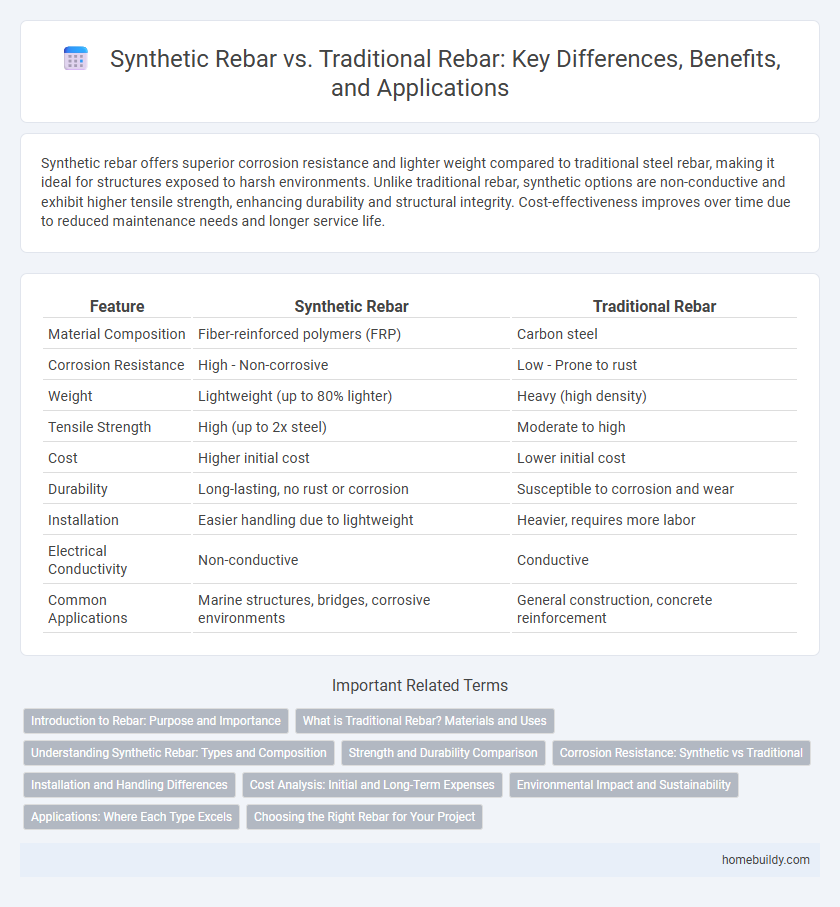Synthetic rebar offers superior corrosion resistance and lighter weight compared to traditional steel rebar, making it ideal for structures exposed to harsh environments. Unlike traditional rebar, synthetic options are non-conductive and exhibit higher tensile strength, enhancing durability and structural integrity. Cost-effectiveness improves over time due to reduced maintenance needs and longer service life.
Table of Comparison
| Feature | Synthetic Rebar | Traditional Rebar |
|---|---|---|
| Material Composition | Fiber-reinforced polymers (FRP) | Carbon steel |
| Corrosion Resistance | High - Non-corrosive | Low - Prone to rust |
| Weight | Lightweight (up to 80% lighter) | Heavy (high density) |
| Tensile Strength | High (up to 2x steel) | Moderate to high |
| Cost | Higher initial cost | Lower initial cost |
| Durability | Long-lasting, no rust or corrosion | Susceptible to corrosion and wear |
| Installation | Easier handling due to lightweight | Heavier, requires more labor |
| Electrical Conductivity | Non-conductive | Conductive |
| Common Applications | Marine structures, bridges, corrosive environments | General construction, concrete reinforcement |
Introduction to Rebar: Purpose and Importance
Rebar, or reinforcing bar, is essential in concrete construction to enhance tensile strength and improve structural integrity. Traditional rebar, typically made of carbon steel, provides reliable reinforcement but is susceptible to corrosion, which can compromise durability. Synthetic rebar, composed of composite materials like fiberglass, offers corrosion resistance and lightweight advantages, extending the lifespan of reinforced concrete structures.
What is Traditional Rebar? Materials and Uses
Traditional rebar is typically made from carbon steel, known for its high tensile strength and durability in reinforcing concrete structures. It is widely used in construction projects such as bridges, buildings, and highways due to its cost-effectiveness and reliable performance under compressive and tensile stresses. The surface of traditional rebar is often ribbed to improve bonding with concrete, enhancing structural integrity.
Understanding Synthetic Rebar: Types and Composition
Synthetic rebar is typically made from advanced polymer materials such as fiberglass, carbon fiber, or basalt fiber composites, offering high tensile strength and corrosion resistance compared to traditional steel rebar. These composites are designed to withstand harsh environmental conditions and chemical exposure, making them ideal for infrastructure projects in coastal or chemically aggressive environments. Different types of synthetic rebar vary in fiber composition and resin matrices, which influence their mechanical properties, durability, and application suitability in reinforced concrete structures.
Strength and Durability Comparison
Synthetic rebar offers superior tensile strength compared to traditional steel rebar, often exceeding it by up to 30%, making it ideal for high-stress construction environments. The corrosion-resistant properties of synthetic rebar significantly enhance durability, preventing rust-related degradation common in steel rebar exposed to moisture and chemicals. Long-term performance studies reveal synthetic rebar maintains structural integrity over extended periods, reducing maintenance costs and increasing lifespan in infrastructure projects.
Corrosion Resistance: Synthetic vs Traditional
Synthetic rebar, made from composite materials such as fiberglass, offers superior corrosion resistance compared to traditional steel rebar, which is prone to rust and degradation when exposed to moisture and chemicals. This enhanced durability extends the lifespan of concrete structures and reduces maintenance costs significantly. In harsh environments like marine or chemically aggressive sites, synthetic rebar's resistance to corrosion prevents structural weakening and enhances safety.
Installation and Handling Differences
Synthetic rebar is significantly lighter than traditional steel rebar, simplifying transportation and reducing labor costs during installation. Its corrosion-resistant properties eliminate the need for protective coatings and allow for easier cutting and bending on-site without specialized equipment. Traditional rebar requires heavy machinery for handling due to its weight and is prone to rust, demanding careful storage and protective measures to maintain integrity during installation.
Cost Analysis: Initial and Long-Term Expenses
Synthetic rebar typically incurs higher initial costs due to advanced manufacturing processes and specialized materials like fiberglass or carbon fiber. Traditional steel rebar has a lower upfront expense but often requires more frequent maintenance and corrosion-related repairs, increasing long-term costs. When evaluating lifecycle expenses, synthetic rebar's resistance to corrosion and reduced need for replacement can lead to significant savings over time despite a steeper initial investment.
Environmental Impact and Sustainability
Synthetic rebar, typically made from fiber-reinforced polymers (FRP), offers significant environmental advantages over traditional steel rebar by reducing carbon emissions and minimizing corrosion-related waste. Unlike steel rebar, which requires energy-intensive mining and smelting processes, synthetic rebar production consumes less energy and extends the lifespan of concrete structures due to its resistance to rust and chemical degradation. The enhanced durability and recyclability of synthetic rebar contribute to sustainable construction practices by lowering maintenance demands and reducing the overall environmental footprint of infrastructure projects.
Applications: Where Each Type Excels
Synthetic rebar excels in corrosive environments such as marine structures, chemical plants, and sewage systems due to its superior resistance to rust and chemical degradation. Traditional steel rebar remains the preferred choice in high-load applications like bridges, highways, and high-rise buildings, where its tensile strength and ductility provide essential structural support. Each type's unique properties determine their optimal use, with synthetic rebar offering longevity in aggressive settings and traditional rebar ensuring reliability under extreme mechanical stress.
Choosing the Right Rebar for Your Project
Synthetic rebar offers superior corrosion resistance and lightweight properties compared to traditional steel rebar, making it ideal for infrastructure in coastal or chemically aggressive environments. Traditional rebar excels in high-load applications due to its proven tensile strength and compatibility with concrete bonding. Selecting the right rebar depends on environmental exposure, structural requirements, and long-term durability for your specific construction project.
Synthetic Rebar vs Traditional Rebar Infographic

 homebuildy.com
homebuildy.com